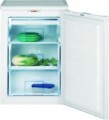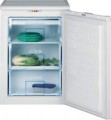Capacity
The total working volume of the freezer compartment. A larger volume allows for more products to be stored, but it affects the size and cost of the unit; therefore, when choosing based on this parameter, it's important not to chase maximum capacity but to consider what volume you actually need. For example, for household use, the average necessary volume is 50 liters per person; and when choosing a display freezer (see "Type"), you need to consider the number of products to be sold. More detailed recommendations for selecting the optimal volume can be found in specialized sources.
It is also worth considering that the freezer is often divided into several compartments (see below) — which means that a large volume does not necessarily guarantee that large pieces of products can fit into the device.
No Frost
No Frost system inside the freezer. A special fan provides air circulation, while moisture condenses in the frost, not in the working chamber, but in a special compartment. Periodically, the fan turns off, the frost melts, and the meltwater flows into a special tray, from which it evaporates. Such a system eliminates the need to defrost the freezer to remove frost periodically. On the other hand, it imposes special requirements on the packaging of products, since in such freezers the products dehydrate fast.
Minimum temperature
The lowest temperature that the freezer can maintain in normal operation. First of all, the duration of food storage in the freezer depends on this parameter: it is believed that a temperature of -12 ° C is enough to preserve food for a month, -18 ° C – 3 months, -24 ° C – up to a year. At the same time, it must be taken into account that not only temperature affects the shelf life but also the type of product and its quality before freezing.
Power failure autonomy
The amount of time the freezer keeps food cold enough when the refrigeration system is turned off, for example, due to a breakdown or power outage. Technically, the power failure autonomy for each model is calculated differently; For example, for a freezer with an operating temperature of -18 ° C, this is the period during which the products in the chamber heat up from -18 ° C to -9 ° C. To sum up, the time is indicated during which the frozen products are guaranteed not to heat up to a temperature at which they could lose their properties.
Freeze capacity
One of the main indicators of freezer performance is the approximate amount of fresh food that the freezer can completely freeze from room temperature to the minimum operating temperature in 24 hours. For domestic use, a power of 10-15 kg/day is considered quite sufficient. More performant models may be required if you have to freeze a lot of food at a time or for industrial purposes.
Fast freeze
It is the forced freezing mode, in which the temperature inside the freezer is briefly reduced to -24 °C. This mode is intended for the case when you need to freeze numerous products at the same time — without a sharp decrease in temperature, the heat from numerous non-frozen products could lead to its critical increase.
Usually, the fast freeze mode must be turned on in advance — 5 to 6 hours before loading the products. Thus the freezer has time to decrease the temperature in the chamber. In this case, it is necessary to take into account the increased load on the compressor — it is impossible to turn on fast freeze for a long time. In some models, automatic shutdown of the fast freeze mode is provided. In some, it must be done manually.
Controls
The type of control provided in the freezer. This parameter is specified by the type of controls and their location.
- Rotary knobs. In general, this is the simplest and most inexpensive option used in units of the appropriate level. However, even this is quite enough - especially if the freezer works in more or less constant temperature conditions (for example, in a home or office kitchen). In many cases, the matter is limited to selecting the appropriate knob position once and then not changing the settings. In addition, the major advantages of this type of control are reliability and ease of repair.
- Push-buttons. Push-buttons are considered more advanced than rotary knobs. The specific functionality of freezers with such a control may be different. But among them, models with additional functions and the ability to fine-tune the temperature are noticeably more common. As for the location, there are internal and external push-buttons. The internal location allows you to hide the control panel behind the refrigerator door, providing a neat appearance with a minimum of protruding parts.
The external location is convenient because you do not need to open the door to access the settings. On the other hand, the real need for such an arrangement is not so often, and the control panel must also fit into the overall design of the unit (which is not always possible to do in the best way).
- Touch controls. Touch controls are considered th...e next step in the development of control panels, after buttons. So, it looks stylish and technologically advanced, they do not need to be pressed hard (just touched), and there are no protruding parts, corners or slots on the surface of the panel, which simplifies cleaning from dirt. The presence of a touch panel is typical mainly for models of the middle and top levels. It costs a little more than a push-button one, but this is imperceptible against the total price of the units. But the internal location, in this case, is much less common than the external one. It is because there is no need to hide the touch panel behind the door. It can easily fit into the design of the device. In addition, external placement allows you not to open the door again to access the settings.
Energy class
The energy class shows how economical the freezer is in terms of electricity consumption. Initially, the classes were designated in Latin letters from A (most economical) to G (high power consumption). Recently, improved classes A+, A++ and A+++ appeared (the more pluses - the more economical the device).
It should be borne in mind that this indicator represents not the actual energy consumption but the efficiency of the unit compared to similar models. Therefore, a small class A freezer may have a lower power consumption than a large class A++ model. And other things being equal, a more economical device, as a rule, costs more, but this difference can quickly pay off during the operation.
Energy consumption per year
It is the average amount of energy consumed by the freezer in a year of operation. Of course, these figures are not absolutely accurate. The actual power consumption may vary depending on the specific operating conditions. However, this parameter makes it possible to evaluate the consumption of the device and compare different models with each other. At the same time, it often turns out to be more convenient and visual than the energy consumption class (see above) because, in this paragraph, we are talking about a specific figure (from which you can also calculate the cost of electricity consumed).

